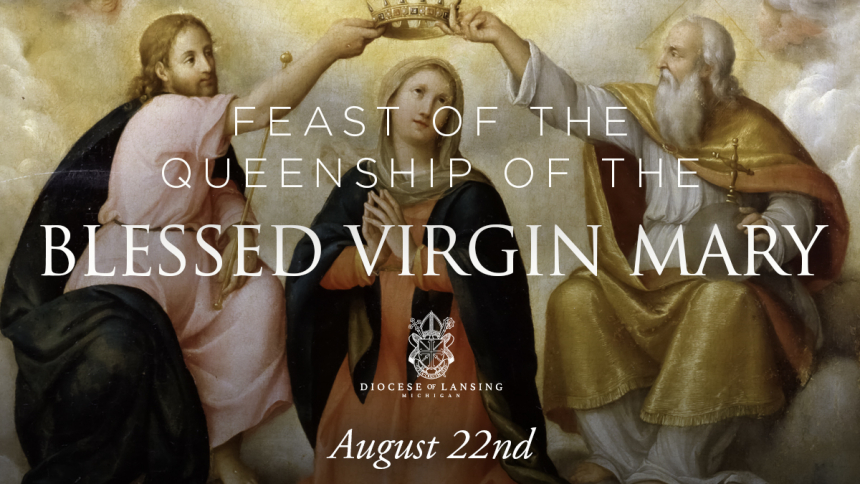
Today is the Feast of the Queenship of the Blessed Virgin Mary. Happy feast day! Why, though, do we celebrate Our Lady as our queen? Here's a great short reflection from Father Tim MacDonald, Vicar General of the Diocese of Lansing and Pastor of Queen of the Miraculous Medal in Jackson. Father MacDonald writes:
Today, August 22nd, the Octave Day of the Blessed Mother’s Assumption into Heaven, we celebrate the Feast of the Queenship of Mary. Of the Diocese of Lansing’s 72 parishes, did you know that 20 of them are named for Our Lady? Many are just named St. Mary’s, but we also have Our Lady of Guadalupe, Our Lady of Fatima, St. Mary Star of the Sea, Immaculate Conception, Immaculate Heart of Mary, and two parishes dedicated to Mary as Queen: St. Mary Queen of Angels in Swartz Creek and the parish where I serve as pastor, Queen of the Miraculous Medal in Jackson.
It was Pope Pius XII who defined Mary’s Assumption into Heaven during the Marian Holy Year of Jubilee in 1950. That same Pope promulgated this feast day of the Blessed Mother on October 11, 1954, with a letter entitled, Ad Caeli Reginam, “To the Queen of Heaven,” in which he wrote:
From the earliest ages of the Catholic church a Christian people, whether in time of triumph or more especially in time of crisis, has addressed prayers of petition and hymns of praise and veneration to the Queen of Heaven. And never has that hope wavered which they placed in the Mother of the Divine King, Jesus Christ; nor has that faith ever failed by which we are taught that Mary, the Virgin Mother of God, reigns with a mother’s solicitude over the entire world, just as she is crowned in heavenly blessedness with the glory of a Queen (par. 1).
In a church that has existed for 2,000 years, a feast that is less than 70 years old seems relatively new, and yet the history of Mary’s queenship stretches back to the first centuries of the Church. In the midst of the ruins of the Roman Forum, once the seat of power of a great empire, you can still visit the little 6th century church of Santa Maria Antiqua, Ancient St. Mary, in which you will find a 1500-year-old mosaic depicting the Blessed Mother as an Empress with a jeweled crown on her head. This fits the description of Our Lady as seen by John the Evangelist in The Book of Revelation, as ‘a woman clothed with the sun, with the moon under her feet, and on her head a crown of twelve stars’ (Rev. 12:1).
Mary gained the title of Queen from the very moment Gabriel announced that she would be with child at the Annunciation in the Grotto at Nazareth. The Archangel promised that her son would sit on ‘the throne of his ancestor David,’ and ‘he will reign over the house of Jacob forever, and of his kingdom there will be no end’ (Luke 1:32-33).
In ancient Israel, the king’s mother always carried the rank of Queen. Requests made of the king were often transmitted through his mother. A most famous example of this practice is found in 2 Kings 13 when Adonijah, fourth son of King David, asks a favor of Queen Bathsheba, requesting that she approach her son King Solomon to allow him to marry. When the queen mother approaches Solomon, he did her homage, not the other way around, and the request was granted.
In the same way, Christians for 2,000 years have approached Jesus through Mary, ad Iesum per Mariam. Jesus would refuse her nothing, so great is his love for her, and we do well to make our requests of him through her holy and grace-filled intercession.
Jesus is a king unlike any other, and his kingdom endures forever, stretching far beyond the confines of earth below or heaven above. In much the same way, the Queenship of Mary is both earthly and heavenly, holy and humble, drawing all who seek her intercession into a deeper love for her and for her son.
We conclude our reflection turning once more to the words of Pope Pius XII in the document instituting this great feast:
Let all, therefore, try to approach with greater trust the throne of grace and mercy of our Queen and Mother, and beg for strength in adversity, light in darkness, consolation in sorrow; above all let them strive to free themselves from the slavery of sin and offer an unceasing homage, filled with filial loyalty, to their Queenly Mother. Let her churches be thronged by the faithful, her feast-days honored; may the beads of the Rosary be in the hands of all; may Christians gather, in small numbers and large, to sing her praises in churches, in homes, in hospitals, in prisons. May Mary's name be held in highest reverence, a name sweeter than honey and more precious than jewels (Par. 48).
And from the time-honored Litany of Loreto: Queen of Angels, Queen of Patriarchs, Queen of Prophets, Queen of Apostles, Queen of Martyrs, Queen of Confessors, Queen of Virgins, Queen of all Saints, Queen conceived without original sin, Queen assumed into heaven, Queen of the most holy Rosary, Queen of families, Queen of peace. Pray for us!
* First published August 22, 2022
